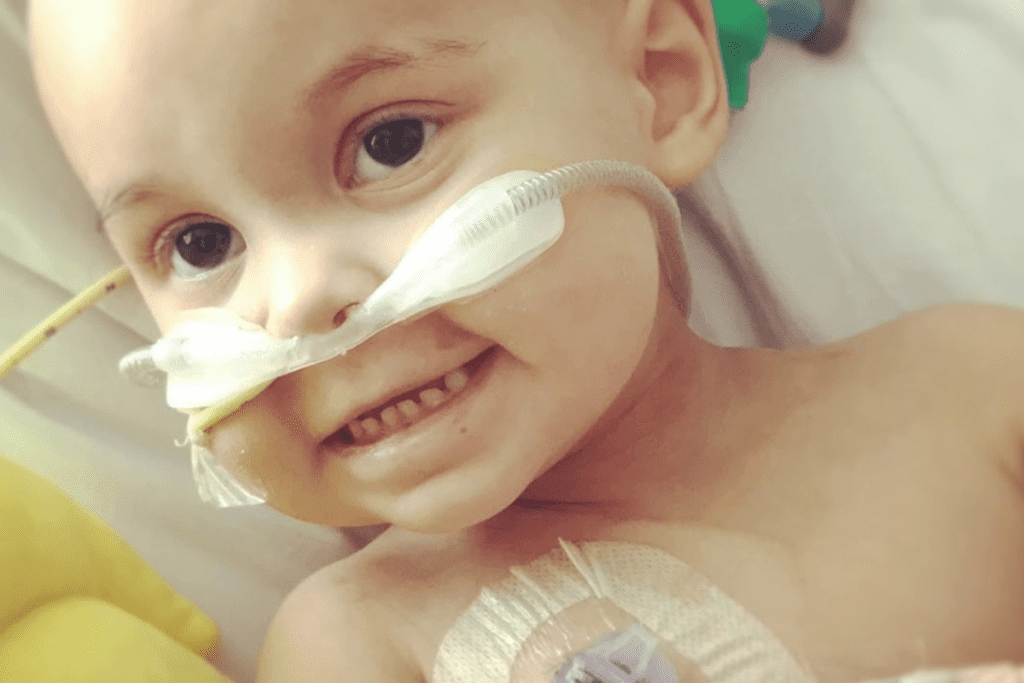Last Updated on October 21, 2025 by mcelik
Acute lymphoblastic leukemia (ALL) gives families the best chance for long-term survival. Thanks to modern treatments, some childhood cancers now have cure rates over 90%. But survival rates differ a lot based on the type of cancer and where you are.

Recent data shows a big jump in 5-year survival rates for ALL. It now stands at 85.1% ±0.4% from 2010-2019, as reported by the SEER Registry. This rise is thanks to better medical treatments and care. Explore the amazing progress in the leukemia survival rate and discover the powerful hope for patients.
Medical science has made big strides in treating pediatric cancers. Knowing about these survival rates is key for patients, families, and doctors. These rates show how well treatments work and guide care choices.

Survival rates in pediatric oncology are measured over 5 years. This means the percentage of kids with cancer who live at least 5 years after being diagnosed. The Surveillance, Epidemiology, and End Results (SEER) Registry study tracks these numbers. It shows big jumps in survival rates for many pediatric cancers.
Calculating survival rates is complex. It looks at many things like the cancer type, the child’s age, and the treatment. Better treatments like chemotherapy and surgery have helped improve these rates.
Several things affect survival rates in pediatric oncology. These include:
For example, leukemia remission rates have gotten much better. This is thanks to better treatments and care. The success rate of leukemia treatment varies, but acute lymphoblastic leukemia (ALL) has a high survival rate.
The 5-year survival rate is a key measure in pediatric oncology. It shows how well treatments work. It helps doctors and researchers see what works best and what needs work.
Improving survival rates means better care for kids with cancer. It helps them live longer and have a better life.
Acute Lymphoblastic Leukemia (ALL) has seen a big jump in survival rates for kids. This is thanks to better treatments and a deeper understanding of the disease.
Today, ALL treatment includes powerful chemotherapy and ways to figure out who needs more help. The 5-year survival rate for children with ALL is now over 90%. This is a big win for kids with cancer.
The 5-year survival rate is key to checking if cancer treatments work. For ALL, this rate has gone up a lot. Now, over 90% of kids under 15 survive for five years. This shows how far medical science has come.

ALL treatment has changed a lot over time. It used to be almost always fatal. Now, thanks to new treatments, many kids can live long lives.
A top oncologist said, “The big leap in ALL treatment comes from detailed clinical trials and using proven medicine.”
“The progress in treating ALL is a result of rigorous clinical trials and the implementation of evidence-based medicine.” – Leading Oncologist
ALL is good at responding to treatment because of its biology and modern chemotherapy. The disease is very sensitive to some drugs. This helps doctors create targeted treatments.
Also, doctors can adjust treatments based on how likely a patient is to do well. This makes treatment more effective for each child.
The success in treating ALL shows what’s possible for other childhood cancers. With more research and better treatments, many more kids can beat cancer.
Looking at survival rates for different types of leukemia gives us key insights. Leukemia is a cancer that affects the blood and bone marrow. It comes in several types, each with its own survival chances and treatment results.
Acute Myeloid Leukemia (AML) is a fast-growing leukemia with its own survival stats. The acute myeloid leukemia survival rate changes a lot. It depends on age, genetic changes, and how well the first treatment works. Studies show that survival rates for AML have gotten better, but they’re not as high as for Acute Lymphoblastic Leukemia (ALL).
The 5-year survival rate for AML patients has slowly gone up. This is thanks to better chemotherapy and targeted treatments. But ML is tough to beat, and kids with certain genetic risks face an even bigger challenge.
Chronic leukemias, like Chronic Myeloid Leukemia (CML) and Chronic Lymphocytic Leukemia (CLL), are less common in kids. But they have different survival chances than acute leukemias. Thanks to new treatments, CML is now more manageable for many patients.
The acute leukemia prognosis depends on many things. These include the leukemia type, genetic changes, age, and how well the first treatment works. For AML, some genetic changes can really affect survival. So, treatments need to be planned carefully based on these factors.
Knowing how these factors affect survival rates is key. It helps us create better treatment plans. This way, we can improve how well patients do.
Leukemia is not the only pediatric cancer with high survival rates. Other cancers like retinoblastoma, Hodgkin lymphoma, and Wilms tumor have also seen big improvements. These advancements in medical treatments have greatly increased their survival rates.
Retinoblastoma is a rare eye cancer mostly found in young kids. Thanks to better treatments, the retinoblastoma survival rate is now close to 95% in developed countries. Early detection and treatments like chemotherapy, laser therapy, and cryotherapy have played a big role in this success. Not only have more kids survived retinoblastoma, but many have also kept their vision. Scientists are working hard to make treatments safer while keeping survival rates high.
Hodgkin lymphoma is a cancer of the immune system that affects kids. The Hodgkin lymphoma survival rate has jumped up, with over 90% of patients surviving five years. Treatments often include chemotherapy and sometimes radiation therapy.
Thanks to better chemotherapy and PET scans for checking how well the treatment works, Hodgkin lymphoma is now much easier to treat. Researchers are trying to make treatments even better and less harmful in the long run.
Wilms tumor, a kidney cancer in kids, has also seen a big jump in survival rates. The Wilms tumor survival rate is now over 90% for those with the best type of tumor. Treatment usually involves surgery, chemotherapy, and sometimes radiation therapy.
Other solid tumors, like some sarcomas and germ cell tumors, have also seen big improvements. Thanks to teams of doctors working together and clinical trials, these patients are living longer and better.
Pediatric cancers come in many forms, each with its own set of challenges. Some types are much harder to treat than others. While many kids with cancer are now cured or live long lives, some diagnoses are tougher to overcome.
Diffuse intrinsic pontine glioma (DIPG) is a tough brain tumor to fight. It’s located in the brainstem and has a poor prognosis. The diffuse intrinsic pontine glioma survival rate is sadly low. Doctors are working hard to find new treatments, like targeted therapies and immunotherapies.
Other brain tumors are also tough to treat. They are complex because of the brain’s anatomy. Doctors must find ways to treat the cancer without harming the brain.
Neuroblastoma starts in the adrenal glands or nerve tissue. High-risk neuroblastoma is very aggressive and hard to treat. Despite tough treatments like chemotherapy and radiation, the high-risk neuroblastoma survival rate is a worry. Researchers are looking for better, less harmful treatments.
For more info on survival rates for pediatric cancers, including leukemia, check out the American Cancer Society’s resource on leukemia survival.
Sarcomas are cancers of connective tissues like bone and muscle. When they spread, they’re hard to treat. Metastatic sarcomas in kids need strong treatments. The metastatic sarcoma survival rate depends on the type and how far it has spread. New treatments like surgery, chemotherapy, and radiation are key to better outcomes.
Treating tough pediatric cancers needs a team effort. Doctors, surgeons, and specialists work together. With ongoing research, there’s hope for better results for kids with these cancers.
The way we treat pediatric cancer has changed a lot. New therapies and care methods have improved survival rates for kids with cancer, like leukemia.
Chemotherapy is key in fighting pediatric cancers, including leukemia. Treatment plans have gotten better over time. They focus on giving high-risk patients stronger treatments and lower doses to others.
Tailoring chemotherapy to each patient’s needs has helped a lot. New, less harmful drugs have also raised survival chances. For example, nucleoside analogs and other new agents have helped fight pediatric leukemia better.
Targeted therapies and immunotherapies have been big steps forward in treating pediatric cancers, like leukemia. These treatments aim to target cancer cells or enhance the immune system’s fight against cancer, which can be gentler on healthy cells.
Targeted therapies, like tyrosine kinase inhibitors, are used for some leukemias. Immunotherapies, like CAR-T cell therapy, are showing great promise in treating hard-to-treat leukemias in kids.
Multidisciplinary care teams are vital in managing pediatric cancer. These teams include experts from many fields, like oncologists, surgeons, and radiologists. Working together, they provide care that fits each patient’s needs.
These teams help mix new treatments, like targeted therapies and immunotherapies, into care plans. They also focus on the support needed by kids going through cancer treatment.
Pediatric cancer survival rates vary greatly around the world. High-income countries have made big strides in saving children’s lives. But low-income countries face huge hurdles in getting kids the care they need.
The 5-year survival rate for children with cancer differs a lot between rich and poor countries. In wealthy nations, the survival rate is 80-90%. But in poorer areas, it drops to 20-30%. This gap is mainly because of healthcare access, diagnostic tools, and treatment options.
In countries with strong healthcare, kids with Acute Lymphoblastic Leukemia (ALL) have a good chance of beating cancer. But, in poorer places, the lack of advanced treatments leads to much lower survival rates.
The main reason for these survival rate gaps is limited access to treatment in poor countries. These areas often lack the right equipment and trained doctors to care for kids with cancer.
To tackle these issues, many international initiatives aim to better pediatric cancer care worldwide. They work on getting more kids diagnosed and treated, improving healthcare setups, and training doctors.
Groups like the International Society of Paediatric Oncology (SIOP) and the World Health Organization (WHO) lead these efforts. They help set up cancer units in poor countries and fund research for affordable treatments.
The future of treating pediatric cancer is looking up. New therapies are being developed. These advancements aim to boost survival rates and improve life quality for kids with cancer.
New treatments are changing how we fight pediatric cancer. Immunotherapy uses the body’s immune system to attack cancer. CAR-T cell therapy is a type of immunotherapy that works well against some cancers.
Targeted therapies focus on specific cancer cells. This reduces harm to healthy cells. It has led to better results and fewer side effects for kids with cancer.
Precision medicine is key in treating pediatric cancer. It tailors treatments to each patient’s unique genetic makeup. Genomic sequencing helps find the cancer’s specific genetic mutations. This leads to more effective treatments.
Using precision medicine has greatly improved diagnosis and treatment. It also opens new paths for studying pediatric cancer genetics.
Some pediatric cancers are harder to treat. Diffuse intrinsic pontine glioma (DIPG) and high-risk neuroblastoma need urgent research. They require new and effective treatments.
Research aims to find better therapies for these cancers. It involves teamwork between scientists, doctors, and industry experts. This collaboration speeds up finding and using new treatments.
With new therapies, precision medicine, and focused research, the outlook for pediatric cancer treatment is hopeful. More research and development are needed. This is essential to enhance survival rates and life quality for all kids with cancer.
The world of pediatric cancer care has changed a lot. Survival rates for some cancers, like Acute Lymphoblastic Leukemia (ALL), have improved a lot.
New treatments like targeted therapies and immunotherapies have helped a lot. They give hope to families dealing with pediatric cancer.
But there are big challenges, like in low-income countries. These places often struggle to get the right diagnosis and treatment.
Research and global efforts are working to solve these problems. They aim to make sure all kids get the care they need, no matter where they live.
We need to keep working hard to help more kids beat cancer. More research and new treatments are key to keeping the progress going.
Yes, leukemia can be cured in some cases. Survival rates have gotten better over time. For example, children with acute lymphoblastic leukemia (ALL) have a 5-year survival rate of about 90%. On the other hand, acute myeloid leukemia (AML) has a survival rate between 40% to 60%. Survival rates for chronic leukemias vary based on the specific type.
The success of leukemia treatment depends on several factors. These include the type of leukemia, the patient’s age, and their overall health. Children with ALL have a high success rate. But ML and other types have lower success rates. Adults with leukemia generally have lower survival rates than children.
The 5-year survival rate for AML is between 40% to 60%. This is much lower than ALL, which has a higher survival rate. Chronic leukemias have survival rates that vary based on the type.
Survival rates for blood cancer differ by age. Children and teens usually have higher survival rates than adults. This is true for certain types of leukemia, like ALL.
Leukemia can be cured in some cases. The chances of remission depend on the type and stage of the disease. ALL has a high cure rate. Other types have lower cure rates. Remission rates are generally higher for children than adults.
Survival rates for childhood leukemia have greatly improved. ALL has a 5-year survival rate of about 90%. Other types, like AML, have also seen better survival rates over time.
Leukemia survival rates vary worldwide. High-income countries generally have better outcomes than low-income countries. Low-income countries face challenges like limited access to treatment and diagnostics. They also lack specialized care teams.
New therapies, like targeted and immunotherapies, are boosting leukemia survival rates. Precision medicine is also key in tailoring treatments. Research is ongoing to find new treatments and improve outcomes for those with a poor prognosis.
Multidisciplinary care teams are vital in improving leukemia survival rates. They provide complete and coordinated care. These teams include specialists from hematology, oncology, and radiation therapy. They work together to create effective treatment plans.
Dowd, S. B., & Pignatello, D. R. (2024). The prevalence of compensation in U.S. clinical trials: An analysis of factors influencing payment. Journal of Clinical Pharmacology, 64(3), 299-315. https://doi.org/10.1002/jcph.2452
Subscribe to our e-newsletter to stay informed about the latest innovations in the world of health and exclusive offers!